Cancer is a worldwide threat and there is no efficient cure for many types of this disease which is caused by damage to genes that control cell growth and division. The most important definitive feature of cancer is abnormal cell divisions that occur in various parts of the body and can spread to other organs (Nayak KA.& Pal D., 2010). The abnormal cell division suppresses the tissue or organ that it surrounds, preventing the tissue or organ from functioning. Early diagnosis is an important consideration in cancer treatment. It is difficult to diagnose cancer in the early stages with traditional diagnostic methods. Advances in nanotechnology, which is a multidisciplinary science, offers important opportunities in terms of cancer diagnosis and treatment. Cancer-causing factors can be grouped into two groups, roughly genetically and environmentally. Only 1% of cancers are caused by genetic transport. Disorders in some genes acquired by heredity cause cancer especially in childhood. However, disorders in genes such as BRCA1 and BRCA2 can cause cancer in older ages. For example, in women with these mutated genes, the risk of breast cancer has been observed to increase by 80% compared to the normal population (Ephrat PE. & Sharon LL, 2003). The remaining 99% of cancers depend on people's eating habits, working conditions, living environments, natural or artificial radiation to which they are exposed, and carcinogenic chemicals. These are called environmental cancer risk factors.In cancer treatments, non-invasively real-time monitoring is a very important issue to determine the progress of healing. And the chemicals used in the treatment have cytotoxic properties, but these drugs must only kill the cancer cells. Practically, we can observe the cytotoxic effects on the cells and show drug efficiency. Also, animals are useful models for these kinds of experiments. On the other hand, these drugs kill normal cells too. This is the situation that we don’t want to as cancer researchers. The cancer researchers try to improve the platforms with high efficiency for cancer treatment, which don’t kill healthy cells, carry the drug to the exact desired point (cancer tissue), and be monitored by the doctors. In this book; we mention cancer treatment, diagnosis with nanotechnology relations, and polymer and lipid-based nanotheranostic platforms.
Inhaltsverzeichnis (Table of Contents)
- INTRODUCTION
- Using Nanotechnology in Cancer Diagnosis and Treatment
- Polymer-based Cancer Nanotheranostics
- Lipid-based Cancer Nanotheranostics
Zielsetzung und Themenschwerpunkte (Objectives and Key Themes)
This book provides a comprehensive overview of the role of nanotechnology in cancer diagnosis and treatment, with a focus on polymer- and lipid-based nanotheranostic platforms. It aims to explore the potential of these platforms for achieving real-time monitoring, targeted drug delivery, and personalized cancer therapy.
- The use of nanotechnology in cancer diagnosis and treatment.
- The advantages and limitations of conventional cancer diagnosis and treatment methods.
- The potential of polymer-based nanotheranostics for improved cancer treatment.
- The application of lipid-based nanotheranostics in cancer therapy.
- The concept of theranostics and its role in personalized medicine.
Zusammenfassung der Kapitel (Chapter Summaries)
- INTRODUCTION: This chapter introduces the concept of cancer, its causes, and the challenges associated with conventional diagnosis and treatment methods. It emphasizes the need for early detection and targeted therapies. The chapter also highlights the potential of nanotechnology in addressing these challenges.
- Using Nanotechnology in Cancer Diagnosis and Treatment: This chapter explores the application of nanotechnology in early cancer diagnosis and the development of targeted therapies. It discusses the limitations of conventional methods and the advantages offered by nanotechnology, such as increased sensitivity and specificity. The chapter also introduces the concept of theranostics and its potential for personalized medicine.
- Polymer-based Cancer Nanotheranostics: This chapter delves into the design and application of polymer-based nanotheranostic platforms. It explores the key characteristics of these platforms, including their stability, targeting ability, and biodistribution properties. The chapter also discusses the advantages of polymer-based platforms in terms of drug delivery and imaging capabilities.
Schlüsselwörter (Keywords)
Cancer, nanotechnology, nanotheranostics, polymer-based, lipid-based, diagnosis, treatment, theranostics, targeted drug delivery, personalized medicine, biodistribution, imaging.
- Quote paper
- M.Sc. Nazli Irmak Giritlioglu (Author), Gizem Köprülülü Küçük (Author), 2020, Polymer- and Lipid-Based Cancer Nanotheranostics, Munich, GRIN Verlag, https://www.hausarbeiten.de/document/903290


